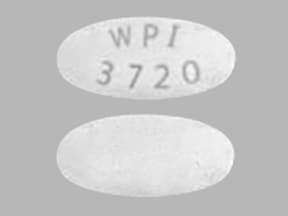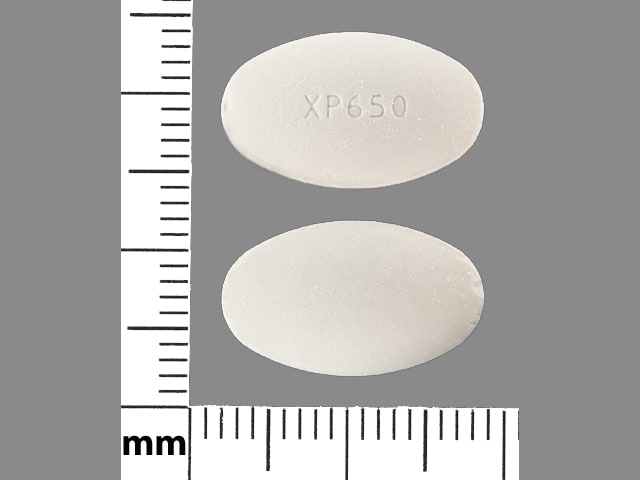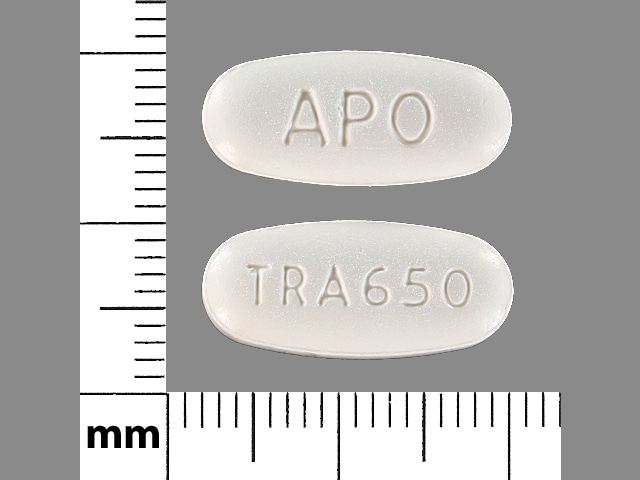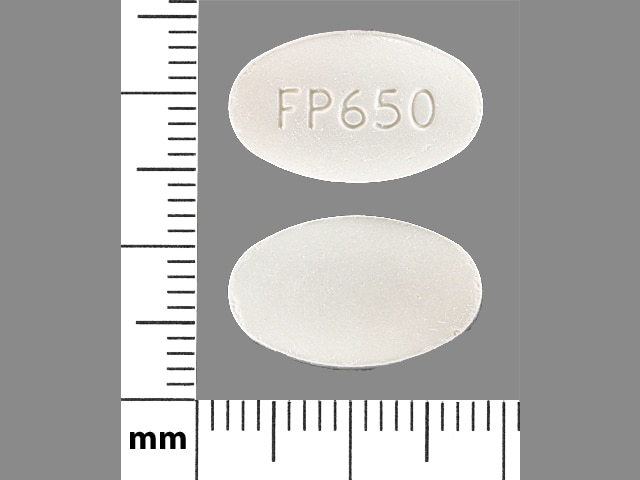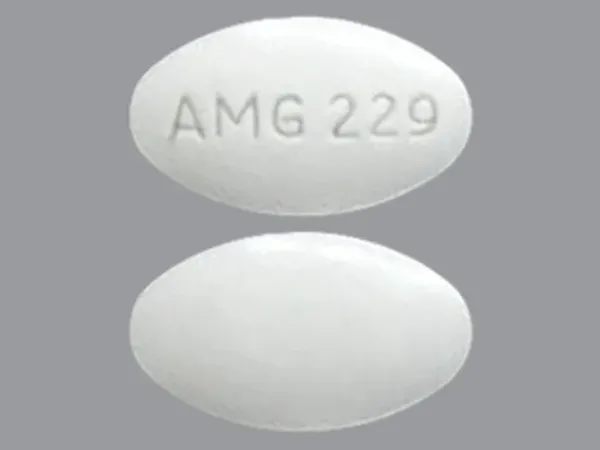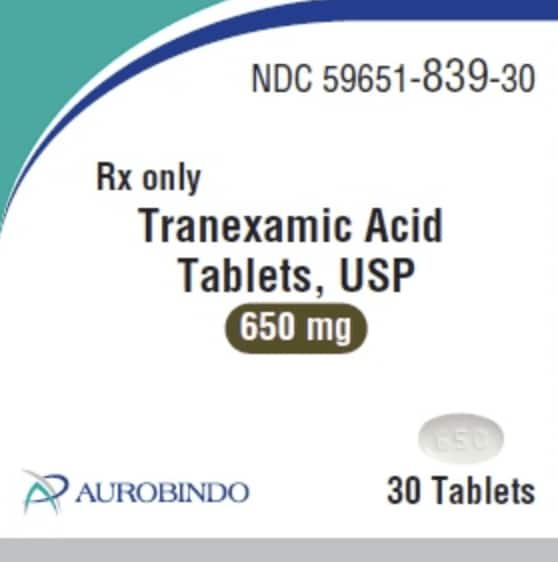Dosage Forms
Excipient information presented when available (limited, particularly for generics); consult specific product labeling.
Solution, Intravenous:
Generic: 1000 mg/10 mL (10 mL)
Solution, Intravenous [preservative free]:
Cyklokapron: 1000 mg/10 mL (10 mL)
Generic: 1000 mg/10 mL (10 mL); 1000 mg/100 mL in NaCl 0.7% (100 mL)
Tablet, Oral:
Lysteda: 650 mg
Generic: 650 mg
Pharmacology
Mechanism of Action
Forms a reversible complex that displaces plasminogen from fibrin resulting in inhibition of fibrinolysis; it also inhibits the proteolytic activity of plasmin
With reduction in plasmin activity, tranexamic acid also reduces activation of complement and consumption of C1 esterase inhibitor (C1-INH), thereby decreasing inflammation associated with hereditary angioedema.
Pharmacokinetics/Pharmacodynamics
Distribution
Vd: 9 to 12 L; CSF levels are 10% of plasma
Excretion
Urine (>95% as unchanged drug)
Time to Peak
Oral: 2.5 hours (range: 1 to 5 hours)
Half-Life Elimination
~2 to 11 hours
Protein Binding
~3%, primarily to plasminogen
Use in Specific Populations
Special Populations: Renal Function Impairment
Following administration of a single IV injection, urinary excretion declines as renal function decreases.
Special Populations: Children
The Cmax and AUC values after a single oral dose of 1,300 mg in adolescent females were 20% to 25% less than those in adult females given the same dose.
In vitro data suggests that neonates require a lower serum tranexamic acid concentration than adults (6.54 mcg/mL vs 17.5 mcg/mL) to completely prevent fibrinolysis (Yee 2013). In pediatric patients weighing 5 to 40 kg undergoing cardiac surgery with by-pass, a target serum concentration range of 20 to 30 mcg/mL has been used in pharmacokinetic analysis (Dowd 2002; Grassin-Deyle 2013).
Use: Labeled Indications
Menstrual bleeding, heavy (oral): Treatment of cyclic heavy menstrual bleeding.
Tooth extraction in patients with hemostatic defects (injection, oral [Cyklokapron; Canadian product]): Short-term use in hemophilia patients to reduce or prevent hemorrhage and reduce need for replacement therapy during and following tooth extraction.
Use: Off Label
Dental procedures in patients on oral anticoagulant therapyyes
Based on the American College of Chest Physicians guidelines for perioperative management of antithrombotic therapy, tranexamic acid is recommended to use, when needed, in combination with the continuation of oral anticoagulant therapy for the perioperative management of patients who require minor procedures.
Hemoptysis (nonmassive), treatmentc
Data from a small, single-center, prospective, randomized, double-blind, placebo-controlled trial suggest that nebulized tranexamic acid may be beneficial for the control of nonmassive hemoptysis by reducing the duration and volume of bleeding, with a low risk for side effects Wand 2018. In addition, data from a small case series suggest that nebulized tranexamic acid may be beneficial for the control of moderate hemoptysis (without severe hypotension, tachycardia, or shock) Segrelles 2016.
Hereditary angioedema, long-term prophylaxisyes
Based on the international World Allergy Organization/European Academy of Allergy and Clinical Immunology guideline for the management of hereditary angioedema, tranexamic acid may be considered as a third-line agent for long-term prophylaxis of hereditary angioedema (HAE) when a C1-inhibitor (human or recombinant) is not available and androgens are contraindicated. Efficacy in suppressing attacks appears low but may benefit some patients. Tranexamic acid is not recommended for treatment of acute HAE attacks.
Hereditary hemorrhagic telangiectasia, epistaxis or other bleeding sitesb
Data from two randomized, double-blind, crossover trials suggest that oral tranexamic acid is beneficial to reduce epistaxis and duration of epistaxis in patients with hereditary hemorrhagic telangiectasia Gaillard 2014, Geisthoff 2014.
Intracranial hemorrhage associated with thrombolytic treatmentyes
Based on the Neurocritical Care Society and the Society of Critical Care Medicine guideline for reversal of antithrombotics in intracranial hemorrhage and the American Heart Association/American Stroke Association (AHA/ASA) guidelines for the early management of patients with acute ischemic stroke, tranexamic acid is suggested as a reversal agent for use in patients with intracranial hemorrhage due to thrombolytics (plasminogen-activator) (eg, alteplase, reteplase, tenecteplase) in addition to cryoprecipitate or when cryoprecipitate is contraindicated or not available in a timely manner.
Perioperative prevention of blood loss and transfusion, cardiac surgerya
Data from multicenter, blinded, randomized, controlled trials support the use of tranexamic acid in the prevention of perioperative bleeding associated with cardiac surgery Fergusson 2008, Myles 2017. Tranexamic acid was associated with a lower risk of bleeding, without a higher risk of death or thrombotic complications within 30 days after surgery compared to placebo Myles 2017. Additional clinical data also support the use of tranexamic acid for the prevention of perioperative bleeding associated with cardiac surgery Gravlee 2008, Nuttall 2008.
Perioperative prevention of blood loss and transfusion, orthopedic surgery (hip or knee arthroplasty)ayes
Data from numerous randomized controlled trials and a meta-analysis demonstrate efficacy of IV tranexamic acid for the reduction of bleeding and transfusion-related complications in patients undergoing orthopedic surgery (eg, hip or knee arthroplasty). Total blood loss, number of transfusions required, and units of blood transfused were significantly reduced, and hematological indices were significantly improved with administration of tranexamic acid Fillingham 2018a, Kim 2014, MacGillivray 2011, Maniar 2012, Xiao 2019, Zufferey 2010.
Based on the American Association of Hip and Knee Surgeons, American Society of Regional Anesthesia and Pain Medicine, American Academy of Orthopaedic Surgeons, Hip Society, and Knee Society guidelines on tranexamic acid use in total joint arthroplasty, tranexamic acid is recommended for reducing blood loss and the need for transfusions during hip or knee arthroplasty.
Perioperative prevention of blood loss and transfusion, spinal surgeryb
Data from numerous prospective, blinded, randomized, controlled trials that were analyzed in a meta-analysis support the use of tranexamic acid to reduce blood loss and the need for transfusions during spinal surgery Lu 2018.
Postpartum hemorrhage, preventionyes
Based on the Network for the Advancement of Patient Blood Management, Haemostasis, and Thrombosis consensus statement on patient blood management in obstetrics: prevention and treatment of postpartum haemorrhage, tranexamic acid, in addition to uterotonics, is recommended for the prevention of postpartum hemorrhage during caesarean delivery. Additionally, expert opinion suggests tranexamic acid is effective for the prevention of primary postpartum hemorrhage during vaginal deliveries Saccone 2019.
Postpartum hemorrhage, treatmentayes
Data from a large international, randomized, double-blind, placebo-controlled trial evaluating the early administration of IV tranexamic acid in women (≥16 years of age) with postpartum hemorrhage following vaginal birth or cesarean delivery support the use of tranexamic acid for treatment of postpartum hemorrhage. A significant reduction in risk of death due to bleeding was observed when treatment was started within 3 hours of birth whereas no apparent risk reduction was seen when given after 3 hours WOMAN Trial Collaborators 2017.
Based on the American College of Obstetricians and Gynecologists practice bulletin on postpartum hemorrhage, IV tranexamic acid is recommended for the treatment of obstetric hemorrhage when initial therapy fails ACOG 183 2017. In addition, the World Health Organization recommends IV tranexamic acid be administered within 3 hours of birth, along with standard care, to women diagnosed with postpartum hemorrhage WHO 2017.
Subarachnoid hemorrhage, prevention of early aneurysmal rebleedingcyes
Data from a randomized, prospective, multicenter, controlled study in patients who suffered aneurysmal subarachnoid hemorrhage suggest that short-term use of tranexamic acid may be beneficial for the prevention of early rebleeding Hillman 2002.
Based on the AHA/ASA guidelines for the management of aneurysmal subarachnoid hemorrhage, the short-term use (<72 hours) of an antifibrinolytic is reasonable to reduce the risk of early aneurysm rebleeding.
Trauma-associated hemorrhage (including traumatic brain injury)a
Data from a large, randomized, placebo-controlled trial evaluating the effects of early administration (ie, within 8 hours, ideally within 3 hours) of tranexamic acid in adult trauma patients with significant hemorrhage or at risk of hemorrhage support the use of tranexamic acid to reduce the risk of death from bleeding in this patient population CRASH-2 Trial Collaborators 2010. In a post-hoc analysis, treatment beyond 3 hours was shown to be significantly less effective and possibly associated with harm CRASH-2 Trial Collaborators 2011. In a subsequent retrospective observational study in patients suffering combat-related injury, the use of tranexamic acid resulted in improved measures of coagulopathy and survival, especially in patients requiring massive transfusion Morrison 2012.
Data from a large, randomized, placebo-controlled trial evaluating the effects of early administration (ie, within 3 hours) of tranexamic acid in adult patients with acute traumatic brain injury support the use of tranexamic acid to reduce the risk of head injury–related death in this population CRASH-3 Trial Collaborators 2019.
Contraindications
Hypersensitivity to tranexamic acid or any component of the formulation
Injection: Acquired defective color vision; active intravascular clotting; subarachnoid hemorrhage. Note: Although subarachnoid hemorrhage (SAH) is listed in the manufacturer’s labeling as a contraindication due to risk of cerebral edema and cerebral infarction, use has been described in the literature for aneurysmal SAH (Roos 2000; Roos 2003). When definitive treatment of the aneurysm is unavoidably delayed and no other contraindications exist, short-term use (<72 hours) of tranexamic acid is a reasonable treatment option to reduce the risk of early rebleeding without an increased risk of vasospasm and delayed ischemia; however, clinical trial data regarding improved outcomes are not conclusive at this time and an increased risk of deep venous thrombosis has been reported (ASA [Connolly 2012]; Chwajol 2008; Starke 2011;).
Oral: Active thromboembolic disease (eg, cerebral thrombosis, DVT, or PE); history of thrombosis or thromboembolism, including retinal vein or retinal artery occlusion; intrinsic risk of thrombosis or thromboembolism (eg, hypercoagulopathy, thrombogenic cardiac rhythm disease, thrombogenic valvular disease); concurrent use of combination hormonal contraception
Canadian labeling: Additional contraindications (not in the US labeling): Injection, oral: History or risk of thrombosis (unless concurrent anticoagulation therapy is possible); hematuria
Dosage and Administration
Dosing: Adult
Note: Safety: Higher total IV doses (eg, ≥50 mg/kg), such as those given perioperatively, may be associated with an increased risk of seizures; lower doses (eg, 1 or 2 g given in the first 8 hours of trauma) do not appear to increase the risk of seizure or venous thromboembolism (CRASH-3 Trial Collaborators 2019; Fillingham 2018a; Lecker 2016; Myles 2017; Sigaut 2014).
Dental procedures in patients on oral anticoagulant therapy (off-label use):
Oral rinse: 5% solution (extemporaneously prepared): Administer 5 to 10 minutes prior to the procedure; hold 5 to 10 mL in mouth and rinse for 2 minutes; drain gently, being careful not to forcibly spit and dislodge clots; do not eat or drink for 1 hour after using oral rinse. Repeat 3 to 4 times daily for 1 to 2 days after the procedure (ACCP [Douketis 2012]; Borea 1993; Gaspar 1997; Lam 2011; Patatanian 2006).
Hemoptysis (nonmassive), treatment (off-label use):
Inhalation for nebulization: 500 mg (using injectable solution) 3 times daily for up to 5 days (Segrelles 2016; Wand 2018).
Hereditary angioedema, long-term prophylaxis (alternative agent) (off-label use):
Note: May be used when other agents (eg, C1-inhibitor, androgens) are not available or contraindicated (WAO/EEACI [Maurer 2018]). The recommended dosage range is based on use of 500 mg tablets available internationally, but not in the United States.
Oral: Initial: 3 g once, followed by 1 to 1.5 g two to three times daily; reduce to 500 mg once or twice daily when frequency of attacks decreases (Gompels 2005; Levy 2010; Zuraw 2019); maximum total daily dose: 4 to 6 g/day (Bowen 2010; WAO/EEACI [Maurer 2018]).
Hereditary hemorrhagic telangiectasia, epistaxis or other bleeding sites (alternative agent) (off-label use):
Note: May be used in carefully selected patients in whom local therapy and other management options are insufficient. The recommended dosage range is based on use of 500 mg tablets available internationally, but not in the United States.
Oral: Initial: 1.5 g twice daily or 1 g three times daily for 4 to 10 days; adjust dose as needed based on response and tolerability to a usual daily dose of 2 to 4.5 g in 2 or 3 divided doses (Gaillard 2014; Geisthoff 2014; Pabinger 2017).
Intracranial hemorrhage associated with thrombolytic treatment (alternative therapy) (off-label use):
Note: Consider for use in addition to cryoprecipitate or when cryoprecipitate is contraindicated in patients who have a symptomatic intracranial hemorrhage after receiving thrombolytic within the past 24 hours (NCS/SCCM [Frontera 2016]).
IV: 1 g (or 10 to 15 mg/kg) once; administer at a rate not to exceed 100 mg/minute (generally over 10 to 20 minutes) (AHA/ASA [Powers 2018]; NCS/SCCM [Frontera 2016]).
Menstrual bleeding, heavy (alternative agent):
Note: Consider for use in women who decline or should not use hormonal therapy. Start once heavy menstrual bleeding has begun.
Oral:
Lysteda: 1.3 g three times daily for up to 5 days during monthly menstruation.
Cyklokapron [Canadian product]: 1 to 1.5 g three to four times daily for several days during menstruation.
Perioperative prevention of blood loss and transfusion (eg, cardiac surgery, other surgeries with significant blood loss):
Note: There is wide variety in doses and routes of administration (IV, oral, and/or topical). Dosing and timing of administration are procedure and institution specific. Recommendations provided below are examples of IV regimens for use in selected surgeries; refer to institutional protocols.
Usual dose and range: IV: 1 g (or 10 to 30 mg/kg) prior to procedure; administer at a rate not to exceed 100 mg/minute (generally over 10 to 30 minutes). Depending upon type of procedure, a continuous infusion may be given intraoperatively after the initial bolus dose, or the bolus dose may be repeated at the end of procedure and/or during the postoperative period.
Cardiac surgery (off-label use):
Note: Optimal regimen is uncertain; refer to institutional protocol.
IV: Loading dose: 10 to 30 mg/kg (usual dose: 1 to 2 g) administered at a rate not to exceed 100 mg/minute (generally over 10 to 20 minutes), followed by 1 to 16 mg/kg/hour (Fergusson 2008; Nuttall 2008; Sigaut 2014). Alternatively, some centers administer a single loading dose of 50 mg/kg (Myles 2017).
Orthopedic surgery (hip or knee arthroplasty) (off-label use):
Note: Optimal regimen is uncertain; refer to institutional protocol. Use in patients without a baseline high risk of thromboembolism. For patients with risk factors for thromboembolism, consider risk of thromboembolism vs benefit of reduced blood loss (Amundson 2019).
IV: 1 g (or 10 to 15 mg/kg) administered before skin incision at a rate not to exceed 100 mg/minute (generally over 10 to 20 minutes); repeat dose at skin closure or up to 12 hours later; some experts recommend a third dose during the postoperative period if needed (AAHKS/ASRA/AAOS [Fillingham 2018b]; Erens 2019; Kim 2014; MacGillivray 2011; Maniar 2012; Martin 2019; Xiao 2019; Zufferey 2010). Note: Some experts use intra-articular tranexamic acid (ie, 1 g per 50 mL of NS applied topically into the wound at the end of the procedure (AAHKS/ASRA/AAOS [Fillingham 2018b]; Alshryda 2013a; Alshryda 2013b).
Spinal surgery (eg, spinal fusion) (off-label use):
Note: Optimal regimen is uncertain; refer to institutional protocol.
IV: 10 to 15 mg/kg administered prior to incision at a rate not to exceed 100 mg/minute (generally over 10 to 20 minutes), followed by 1 to 2 mg/kg/hour as a continuous infusion for the remainder of the surgery; discontinue at the end of the procedure (Brown 2019; Lu 2018; Wong 2008).
Postpartum hemorrhage, prevention (adjunctive therapy) (off-label use):
Note: For use in women in high–bleeding risk situations in conjunction with standard prophylactic uterotonics (eg, oxytocin) (Berghella 2019; Muñoz 2019).
IV: 1 g over 10 to 20 minutes (Berghella 2019; Saccone 2019).
Postpartum hemorrhage, treatment (off-label use):
Note: For continued bleeding despite oxytocin; used in conjunction with other therapies/procedures.
IV: 1 g over 10 to 20 minutes given within 3 hours of vaginal birth or cesarean delivery. If bleeding continues after 30 minutes, may repeat the dose in conjunction with thorough re-evaluation for cause of continued or recurrent bleeding (WOMAN Trial Collaborators 2017).
Subarachnoid hemorrhage, prevention of early aneurysmal rebleeding (off-label use):
Note: Consider for use to prevent early rebleeding when surgical treatment (eg, surgical clipping, endovascular coiling) is delayed (AHA/ASA [Connolly 2012]; Singer 2019; Suarez 2015). Optimal regimen has not been established; refer to institutional protocol.
IV: 1 g over 10 minutes immediately after diagnosis, followed by 1 g every 6 hours for no more than 72 hours (Hillman 2002). Some experts recommend 1 g, followed by 1 g over 8 hours as a continuous infusion, for no more than 36 hours (Post 2019).
Tooth extraction in patients with hemostatic defects (eg, hemophilia, von Willebrand disease, other factor deficiencies associated with bleeding) (adjunctive therapy):
Note: Generally used in conjunction with (and not as a substitute for) replacement of the appropriate clotting factor, especially in individuals with hemophilia. Do not give simultaneously with an activated prothrombin complex concentrate, as this can increase the risk of thromboembolism; if used concurrently, they should be separated by ≥12 hours (WFH [Srivastava 2013]). Consultation with a hemophilia treatment center is advised.
IV: 10 mg/kg (usual dose range: 500 mg to 1 g) administered ~2 hours before procedure at a rate not to exceed 100 mg/minute (generally over 10 to 20 minutes), then 10 mg/kg 3 to 4 times daily for 2 to 8 days. Alternatively, 10 mg/kg as a single dose 2 hours prior to procedure; following procedure, transition to oral tranexamic acid depending on individual patient characteristics, type of procedure, other therapies, and degree of bleeding (Cyklokapron Canadian product monograph; van Galen 2019).
Oral: 25 mg/kg (usual dose range: 1 to 1.5 g) given 2 hours prior to procedure, then 25 mg/kg (usual dose range: 1 to 1.5 g) 3 to 4 times daily for up to 7 to 10 days (Cyklokapron Canadian product monograph; Hoots 2019; van Galen 2019). The recommended oral dosage range is based on use of 500 mg tablets available internationally, but not in the United States.
Trauma-associated hemorrhage (including traumatic brain injury) (off-label use):
Note: Consider for use in patients with significant hemorrhage, at risk of significant hemorrhage, or in mild to moderate traumatic brain injury (TBI) (Glasgow Coma Scale [GCS] score 9 to 15); patients with severe TBI (GCS score 3 to 8) may not demonstrate benefit (CRASH-2 Trial Collaborators 2010; CRASH-3 Trial Collaborators 2019).
IV: Loading dose: 1 g over 10 minutes started within 3 hours of injury, followed by 1 g over the next 8 hours as a continuous infusion. Note: Some experts suggest using thromboelastogram or rotational thromboelastometry to guide repeat dosing (Callum 2019; CRASH-2 Trial Collaborators 2010; CRASH-2 Trial Collaborators 2011; CRASH-3 Trial Collaborators 2019; Galvagno 2019).
Dosing: Geriatric
Refer to adult dosing.
Dosing: Pediatric
Menorrhagia: Female Children ≥12 years and Adolescents: Oral: Tablet: 1,300 mg 3 times daily; maximum daily dose: 3900 mg/day for up to 5 days during monthly menstruation
Prevention of bleeding associated with tooth extraction in hemophilic patients (in combination with replacement therapy): Infants, Children, and Adolescents: IV: 10 mg/kg immediately before surgery, then 10 mg/kg/dose 3 to 4 times daily; may be used for 2 to 8 days
Prevention of bleeding associated with cardiac surgery: Limited data available; reported regimens variable and ideal dose-response not established: Infants, Children, and Adolescents ≤15 years: IV: 10 mg/kg into the by-pass circuit after induction, during cardiopulmonary bypass, and after protamine reversal of heparin for a total of 3 doses; regimen used in two separate trials (n=80, age range: 2 months to 15 years) (Chauhan, 2004; Chauhan, 2004a). Also reported in the younger patients undergoing cardiac surgery (typically <2 years or 20 kg): Loading dose: 100 mg/kg, followed by 10 mg/kg/hour IV infusion (continued until ICU transport) and 100 mg/kg priming dose into the circuit when by-pass initiated (Reid, 1997; Schindler, 2011). In children 1 to 12 years and weighing 5 to 40 kg, a pharmacokinetic analysis proposed the following regimen to achieve a target serum concentration range of 20 to 30 mcg/mL: IV: Loading dose: 6.4 mg/kg over 5 minutes followed by a weight-adjusted continuous infusion in the range of 2 to 3.1 mg/kg/hour; the pharmacokinetic data showed that patients weighing less should receive an initial infusion rate at the higher end of the range (ie, if patient weight =5 kg then initial infusion rate: 3.1 mg/kg/hour; or if patient weight =40 kg then initial infusion rate: 2 mg/kg/hour) (Grassin-Deyle, 2013)
Prevention of perioperative bleeding associated with spinal surgery (eg, idiopathic scoliosis): Limited data available; reported dosing regimens variable; ideal dose response not established: Children ≥8 years and Adolescents: IV: Loading dose: 100 mg/kg, followed by infusion at 10 mg/kg/hour until skin closure (Sethna, 2005; Shapiro 2007). Other reported regimens with positive results: Loading dose: 20 mg/kg, followed by 10 mg/kg/hour infusion (Grant, 2009) or loading dose: 10 mg/kg and 1 mg/kg/hour infusion (Grant, 2009; Neilipovitz, 2001)
Prevention of perioperative bleeding associated with craniosyntosis surgery: Limited data available; reported dosing regimens variable; ideal dose-response not established: Infants ≥2 months and Children ≤6 years: IV: Loading dose of 50 mg/kg over 15 minutes prior to incision, followed by infusion at 5 mg/kg/hour until skin closure (Goobie, 2011) or 15 mg/kg over 15 minutes prior to incision, followed by infusion at 10 mg/kg/hour until skin closure (Dadure, 2011)
Hereditary angioedema (HAE), prophylaxis: Limited data available: Children and Adolescents:
Long-term prophylaxis: Oral: 20 to 75 mg/kg/day in 2 to 3 divided doses; maximum daily dose range: 3,000 to 6,000 mg/day (Bowen, 2010; Farkas, 2007; Gompels, 2005; Zuraw, 2013) or 1,000 to 2,000 mg daily (~50 mg/kg/day; depending on age and size of patient); may consider alternate-day regimen or twice-weekly regimen when frequency of attacks reduces; diarrhea may be a dose-limiting side effect (Gompels, 2005)
Short-term prophylaxis (eg, prior to surgical or diagnostic interventions in head/neck region): Oral:
Weight-directed: 20 to 40 mg/kg/day in 2 to 3 divided doses; maximum daily dose: 6,000 mg/day (Bowen, 2010; Farkas, 2007); other guidelines suggest 50 to 75 mg/kg/day in 2 to 3 divided doses (Craig [WAO], 2012)
Fixed dosing: Patients with an adequate weight (eg, ≥50 kg): 500 mg 4 times daily (Gompels, 2005); therapy usually initiated 2 to 5 days before dental work and continue for 2 days after the procedure (Bowen, 2004; Gompels, 2005)
Traumatic hyphema: Limited data available: Children and Adolescents: Oral: 25 mg/kg/dose every 8 hours for 5 to 7 days (Rahmani, 1999; Vangsted, 1983). Note: This same regimen may also be used for secondary hemorrhage after an initial traumatic hyphema event.
Reconstitution
Tranexamic acid doses using ampules/vials may be diluted in 50 to 250 mL of NS or D5W (CRASH-2 Trial Collaborators 2010; Ducloy-Bouthors 2011; Elwatidy 2008; Fergusson 2008). According to the manufacturer, tranexamic acid may be mixed with most solutions for infusion such as electrolyte solutions, carbohydrate solutions, amino acid solutions, and dextran solutions. Note: A 10 mg/mL premixed solution formulation is also available.
Extemporaneously Prepared
A 5% (50 mg/mL) oral solution may be prepared by diluting 5 mL of 10% (100 mg/mL) tranexamic acid injection with 5 mL sterile water. Label “refrigerate”. Stable for 5 days refrigerated.
A 25 mg/mL oral suspension may be prepared with tablets. Place one 500 mg tablet (strength not available in U.S.) into 20 mL water and let stand ~2 to 5 minutes. Begin stirring and continue until the tablet is completely disintegrated, forming a fine particulate suspension (dispersion time for each 500 mg tablet is ~2 to 5 minutes). Administer immediately after preparation.
Lam MS, "Extemporaneous Compounding of Oral Liquid Dosage Formulations and Alternative Drug Delivery Methods for Anticancer Drugs," Pharmacotherapy 2011, 31(2):164-92.21275495
Administration
Inhalation via nebulization (off-label use/route): Administer over 15 minutes via jet nebulizer (Segrelles 2016; Wand 2018).
Injection: May be administered by direct IV injection at a maximum rate of 100 mg/minute (Crash-trial collaborators 2010; Elwatidy 2008; WOMAN Trial Collaborators 2017); faster rates may cause hypotension.
Oral: Administer without regard to meals. Swallow tablet whole; do not break, chew, or crush.
Storage
IV:
Ampules and vials: Diluted mixture may be stored for up to 4 hours at room temperature. However, solutions prepared in NS are chemically stable for up to 180 days at room temperature (McCluskey 2014). In another study, tranexamic acid (undiluted) was shown to be chemically stable for up to 12 weeks when stored at -20°C, 4°C, 22°C, and 50°C; freezing tranexamic acid in original ampules is unacceptable due to cracking of the ampules (de Guzman 2013). Freezing tranexamic acid in original vials has not been evaluated.
Premixed solution: Store at 25°C (77°F); excursions permitted to 15°C to 30°C (59°F to 86°F).
Tablets: Store at 25°C (77°F); excursions permitted to 15°C to 30°C (59°F to 86°F).
Tranexamic Acid Images
Drug Interactions
Anti-inhibitor Coagulant Complex (Human): Antifibrinolytic Agents may enhance the thrombogenic effect of Anti-inhibitor Coagulant Complex (Human). Avoid combination
Estrogen Derivatives (Contraceptive): May enhance the thrombogenic effect of Tranexamic Acid. Avoid combination
Progestins (Contraceptive): May enhance the thrombogenic effect of Tranexamic Acid. Avoid combination
Tretinoin (Systemic): May enhance the thrombogenic effect of Antifibrinolytic Agents. Monitor therapy
Adverse Reactions
>10%:
Central nervous system: Headache (oral: 50%)
Gastrointestinal: Abdominal pain (oral: 20%)
Neuromuscular & skeletal: Back pain (oral: 21%), musculoskeletal pain (oral: 11%)
Respiratory: Nasal signs and symptoms (oral: 25%; including sinus symptoms)
1% to 10%:
Central nervous system: Fatigue (oral: 5%)
Hematologic & oncologic: Anemia (oral: 6%)
Neuromuscular & skeletal: Arthralgia (oral: 7%), muscle cramps (oral: ≤7%), muscle spasm (oral: ≤7%)
<1%, postmarketing, and/or case reports: Allergic dermatitis, allergic skin reaction, anaphylactic shock, anaphylactoid reaction, anaphylaxis, cerebral thrombosis, chromatopsia, conjunctivitis (ligneous), deep vein thrombosis, diarrhea, dizziness, hypersensitivity reaction, hypotension (with rapid IV injection), nausea, pulmonary embolism, renal cortical necrosis, retinal artery occlusion, retinal vein occlusion, seizure, ureteral obstruction, visual disturbance, vomiting
Warnings/Precautions
Concerns related to adverse effects:
- CNS depression: May cause CNS depression, which may impair physical or mental abilities; patients must be cautioned about performing tasks which require mental alertness (eg, operating machinery or driving).
- Hypersensitivity reactions: Severe hypersensitivity reactions, including anaphylaxis or anaphylactoid reaction have been reported. Discontinue use if serious reactions occur; do not reinitiate treatment.
- Ocular effects: Visual defects (eg, color vision change, visual loss) and retinal venous and arterial occlusions have been reported; discontinue treatment if ocular changes occur; prompt ophthalmic examination should be performed by an ophthalmologist. Use of the injection is contraindicated in patients with acquired defective color vision. Ligneous conjunctivitis has been reported with the oral formulation but resolved upon discontinuation of therapy.
- Seizure: Seizures have been reported with use; most often with intraoperative use (eg, open chamber cardiac surgery and in patients inadvertently administered into the neuraxial system) and in older patients (Murkin 2010). The mechanism by which tranexamic acid use results in seizures may be secondary to neuronal GABA and glycine inhibition or cerebral emboli (Levy 2018). Consider EEG monitoring for patients with history of seizures or who experience myoclonic movements, twitching, or evidence of focal seizures. Discontinue use if seizures occur.
- Thrombotic events: Venous and arterial thrombosis or thromboembolism, including central retinal artery/vein obstruction, has been reported. Use the injection with caution in patients with thromboembolic disease; oral formulation is contraindicated in patients with a history of or active thromboembolic disease or with an intrinsic risk of thromboembolic events (eg, thrombogenic valvular disease, thrombogenic cardiac rhythm disease, hypercoagulopathy). Concomitant use with certain procoagulant agents (eg, anti-inhibitor coagulant complex/factor IX complex concentrates, oral tretinoin, hormonal contraceptives) may further increase the risk of thrombosis; concurrent use with either the oral or injectable formulation may be contraindicated, not recommended, or to be used with caution.
- Ureteral obstruction: Use the injection with caution in patients with upper urinary tract bleeding, ureteral obstruction due to clot formation has been reported.
Disease-related concerns:
- Disseminated intravascular coagulation: Use with extreme caution in patients with disseminated intravascular coagulation requiring antifibrinolytic therapy; patients should be under strict supervision of a health care provider experienced in treating this disorder.
- Renal impairment: Use with caution in patients with renal impairment; dosage modification necessary.
- Subarachnoid hemorrhage: Use with caution in patients with subarachnoid hemorrhage (SAH); cerebral edema and infarction may occur. According to the manufacturer's labeling, use of the injection is contraindicated in patients with SAH; however, use has been described in the literature for aneurysmal SAH and is considered a reasonable treatment option in select patients (ASA [Connolly 2012]).
- Vascular disease: Use with caution in patients with uncorrected cardiovascular or cerebrovascular disease due to the complications of thrombosis.
Concurrent drug therapy issues:
- Drug-drug interactions: Potentially significant interactions may exist, requiring dose or frequency adjustment, additional monitoring, and/or selection of alternative therapy. Consult drug interactions database for more detailed information.
Monitoring Parameters
Ophthalmic examination (visual acuity, color vision, eye-ground, and visual fields) at baseline and regular intervals during the course of therapy in patients being treated for longer than several days; signs/symptoms of hypersensitivity reactions, seizures, thrombotic events, and ureteral obstruction
Pregnancy
Pregnancy Considerations
Tranexamic acid crosses the placenta; concentrations within cord blood are similar to maternal serum.
Use of oral tranexamic acid for the long-term prophylaxis of HAE in pregnant females has been reported (González-Quevedo 2016; Machado 2017; Milingos 2009). Tranexamic acid may be considered for long-term prophylaxis when preferred treatment is not available (WAO/EEACI [Maurer 2018]).
Intravenous tranexamic acid has been evaluated for the treatment of postpartum hemorrhage (Ducloy-Bouthors 2011; WOMAN Trial Collaborators 2017). A significant reduction in risk of death due to bleeding was observed when treatment was started within 3 hours of vaginal birth or cesarean section (WOMAN Trial Collaborators 2017). Tranexamic acid is recommended for the treatment of obstetric hemorrhage when initial therapy fails (ACOG 183 2017; WHO 2017). IV tranexamic acid has also been studied for prophylaxis of postpartum hemorrhage in low-risk females prior to vaginal or cesarean delivery (Novikova 2015; Sentilhes 2018; Simonazzi 2016). However, available data related to prophylactic use is insufficient and use for routine prophylaxis against postpartum hemorrhage is not currently recommended outside of the context of clinical research (ACOG 183 2017).
Patient Education
What is this drug used for?
- It is used to treat or prevent bleeding in patients with hemophilia after having a tooth removed.
- It is used to treat heavy bleeding during monthly periods (menstruation).
- It may be given to you for other reasons. Talk with the doctor.
Frequently reported side effects of this drug
- Abdominal pain
- Back pain
- Muscle pain
- Joint pain
- Stuffy nose
- Muscle cramps
- Nausea
- Vomiting
- Diarrhea
Other side effects of this drug: Talk with your doctor right away if you have any of these signs of:
- Blood clots like numbness or weakness on one side of the body; pain, redness, tenderness, warmth, or swelling in the arms or legs; change in color of an arm or leg; chest pain; shortness of breath; fast heartbeat; or coughing up blood
- Severe cerebrovascular disease like change in strength on one side is greater than the other, trouble speaking or thinking, change in balance, or vision changes
- Flushing
- Severe headache
- Vision changes
- Eye pain
- Severe eye irritation
- Severe loss of strength and energy
- Seizures
- Severe dizziness
- Passing out
- Signs of a significant reaction like wheezing; chest tightness; fever; itching; bad cough; blue skin color; seizures; or swelling of face, lips, tongue, or throat.
Note: This is not a comprehensive list of all side effects. Talk to your doctor if you have questions.
Consumer Information Use and Disclaimer: This information should not be used to decide whether or not to take this medicine or any other medicine. Only the healthcare provider has the knowledge and training to decide which medicines are right for a specific patient. This information does not endorse any medicine as safe, effective, or approved for treating any patient or health condition. This is only a brief summary of general information about this medicine. It does NOT include all information about the possible uses, directions, warnings, precautions, interactions, adverse effects, or risks that may apply to this medicine. This information is not specific medical advice and does not replace information you receive from the healthcare provider. You must talk with the healthcare provider for complete information about the risks and benefits of using this medicine.
